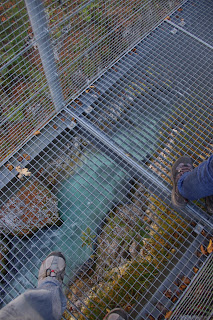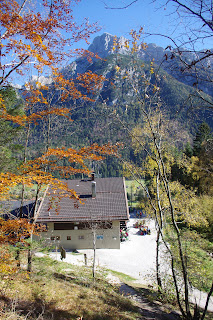In mid-October I went to Munich for 2 weeks to attend a conference and do some laboratory work. The weather put on a good show in this short period of time, as gorgeous autumn sceneries suddenly gave way to an early and abrupt arrival of a snow-covered landscape!
十月中到慕尼黑開會議和做實驗兩星期,在短短的時間內感受到秋天最美的一面和突如其來、提早來臨的冬天!
As I was on board the train from Frankfurt Airport to Munich upon arrival on 15th October, I already noticed that this autumn has started later than usual as the forests en route were still displaying a mix of green, amber and yellow and very few trees had all the leaves shed. And upon arrival in Munich, I was delighted to see the neighbourhood near my research institute and the streets in the city were all in lively autumn colours. Under the blue skies and mild autumn sunshine, the red and golden leaves looked especially brilliant and gave the world an extra warm and cosy feeling.
我10月15日在法蘭克福下飛機,再轉乘火車往慕尼黑,沿途樹林橙色、黃色如綠色斑駁,仍未有廣泛落葉的跡象,心想這個秋天可能比平時遲來吧。到了慕尼黑,不論在研究所周圍,或是會議場地附近,甚至市內的大街小巷,都不難發掘出一幅幅迷人的景緻,尤其是天晴時,在柔和的秋日照耀下,樹葉的金黃色和嫣紅色份外鮮明,也令人有份額外的溫暖感覺。

The last of this autumn's sunflowers
時日無多





Rustic charm in Schwabing, Munich
My first week in Munich was met with sunny weather everyday with a maximum temperature of up to 20 degrees. It would be such a pity to let such beautiful days go to waste, and indeed my good friend in Munich and I decided to make the best use of it with a day trip to Mittenwald (south of Munich) and the Leutaschklamm gorge nearby. Leutaschklamm is located on the border between Germany and Austria and flanked by forests on both sides, but there are very few vantage points for the gorge. Thanks to funding by the European Union, a network of metal walkways is now built halfway up the cliff faces of the gorge to connect the forests together and allow the visitors to enjoy the sceneries of the gorge close up (but don’t look beneath your feet to the bottom of the gorge if you’re afraid of heights!) With its gentle terrain and many educational displays along the tracks, the gorge has attracted many families bringing young children for an easy walk. It was indeed memorable to be able to walk in mid-air directly above the bottom of the gorge, and the autumn colours have added some rustic charm to the countryside scenery.
在慕尼黑的第一週,每天天公造美,而且日間最暖時有20度,這些美好的時光真不容白白讓其溜走,我和一個慕尼黑好友便相約在10月21日那天到慕尼黑以南的Mittenwald和附近的Leutaschklamm峽谷遠足。Leutaschklamm位德國和奧地利邊界,峽谷兩側是一片叢林,地勢並不太險要,但沒甚麼地點可以望到峽谷,多得歐盟撥款沿著懸崖山腰搭建了一系列鐵橋,既連接了兩國,又令遊人可以更近距離從半空欣賞峽谷的景色(不過畏高者別從腳底下望谷底的急流了!)而且沿途設置了吸引小童的玩意和說明,所以很多人一家大小一同前往郊遊。從峽谷的半空欣賞秋色,不啻是難得的經歷,而四周的風景在秋色襯托下,增添了不少色彩。



The houses in Mittenwald Mittenwald鎮內的房屋




The gorge itself was not so big and we have seen most of it after 3 hours. With half an afternoon to spare, my friend and I decided to go for a walk along the Isar river to the nearby Austrian town of Scharnitz. It felt like a walk in the park as there was no border control while the geology and vegetation along the track were pretty similar to the woods near the research institute in Munich. We actually couldn’t even tell where the border was exactly! Once in Scharnitz, we hiked up to the ruins of the former Porta Claudia fortress, but we were left slightly disappointed because there wasn’t much nice scenery to be seen within the fortress area and afar.
不過峽谷範圍不大,不消三小時左右都看得七七八八,為了消磨時間,我和好友便從峽谷出來,沿著Isar河走到毗鄰的奧地利小鎮Scharnitz看個究竟。沿河的路徑土質和植被其實和慕尼黑研究所附近的樹林差不多,再加上沒有邊檢,這個跨境行跟逛公園一樣輕鬆,甚至邊界在哪裡我們也說不情呢!到了Scharnitz,我們特意上山到Porta Claudia城堡廢墟一遊,不過山上風景四周淩亂,遠方的景色亦非突出,覺得有點浪費了腳骨力!


Scharnitz

The weather gradually turned colder in the second week in Munich, culminating in a snowfall at the weekend (27th to 28th October). Although a brief snowfall is generally a common sight in Munich at the end of October, the one that weekend was most unusual on several accounts. It snowed continuously for 24 hours until Sunday lunch time then further for 7 to 8 hours after a 2-hour pause. By the end there were 15 cm of snow built up on the grass while the leaves have received a decent coating of snow. Normally snow would only come when most of the leaves have dropped off leaving behind a few brown and dull yellow ones. But when it snowed even longer than in normal winter while the autumn leaves were still on the trees, it produced a rather unusual palette of colours on the trees with a dusting of white on the red, amber and green leaves. I felt really excited by such views and braved the cold on the Sunday morning to look for good photo shots near the research institute!
之後在慕尼黑的第二週,天氣逐漸轉涼,周未(10月27至28日)還下起雪來,本來慕尼黑在十月底下小雪是極正常的事,但這場雪一下便下了24小時,星期日中午歇了兩小時後再下7、8個小時,草地積起了15厘米的雪,而樹葉面也鋪了一層白色。這場雪最不尋常的是,平常要待秋葉落得七七八八、祇剩一些枯黃和啡色葉片時才會迎來入冬的第一場雪,但這次仍是滿樹鮮紅和金黃的時候,便下了一場比一般冬雪還要久的雪,雪的白色和樹葉的紅、黃、綠色夾雜,情景難得一見,令我大喜過望,所以星期日早上有空閒,忍冷也得到研究所附近踏雪尋「景」拍攝!







It was a magical feeling seeing the snow, as I was shopping for Christmas decorations when the snow first started and the snow began to build up on the way home. It felt as if Christmas has arrived early! I normally wouldn’t venture far when it snows, but on Saturday and Sunday nights I went into the city respectively to have dinner with my good friend in Munich and take my Dutch buddy on a tour around town (while he and his girlfriend were visiting) and uncovered more beautiful snow sceneries at night. It was indeed memorable to witness this extraordinary snowfall!
那個週末剛下雪時,我正好在選購聖誕裝飾,回家時但見開始積雪,一種聖誕感覺由然而生,很是奇妙。平常下雪時我甚少外出,但那兩晚,星期六晚好友約我吃飯,星期日晚帶荷蘭好友觀賞雪景(他和女友來慕尼黑度假數天),見到從前沒留意的景色。這場雪來得急、下得久,和種種雪景,都令我印象深刻。


十月中到慕尼黑開會議和做實驗兩星期,在短短的時間內感受到秋天最美的一面和突如其來、提早來臨的冬天!
As I was on board the train from Frankfurt Airport to Munich upon arrival on 15th October, I already noticed that this autumn has started later than usual as the forests en route were still displaying a mix of green, amber and yellow and very few trees had all the leaves shed. And upon arrival in Munich, I was delighted to see the neighbourhood near my research institute and the streets in the city were all in lively autumn colours. Under the blue skies and mild autumn sunshine, the red and golden leaves looked especially brilliant and gave the world an extra warm and cosy feeling.
我10月15日在法蘭克福下飛機,再轉乘火車往慕尼黑,沿途樹林橙色、黃色如綠色斑駁,仍未有廣泛落葉的跡象,心想這個秋天可能比平時遲來吧。到了慕尼黑,不論在研究所周圍,或是會議場地附近,甚至市內的大街小巷,都不難發掘出一幅幅迷人的景緻,尤其是天晴時,在柔和的秋日照耀下,樹葉的金黃色和嫣紅色份外鮮明,也令人有份額外的溫暖感覺。

The last of this autumn's sunflowers
Klinikum Grosshadern
Grosshadern醫院


The red ivy leaves and the trumpet fountain outside the conference venue Gasteig
會議場地Gasteig外的紅滕葉和喇叭噴泉

A sea of golden colour in the research institute
研究所一片金黃色

Rustic charm in Schwabing, Munich
慕尼黑Schwabing區繽紛的滕樹外牆
My first week in Munich was met with sunny weather everyday with a maximum temperature of up to 20 degrees. It would be such a pity to let such beautiful days go to waste, and indeed my good friend in Munich and I decided to make the best use of it with a day trip to Mittenwald (south of Munich) and the Leutaschklamm gorge nearby. Leutaschklamm is located on the border between Germany and Austria and flanked by forests on both sides, but there are very few vantage points for the gorge. Thanks to funding by the European Union, a network of metal walkways is now built halfway up the cliff faces of the gorge to connect the forests together and allow the visitors to enjoy the sceneries of the gorge close up (but don’t look beneath your feet to the bottom of the gorge if you’re afraid of heights!) With its gentle terrain and many educational displays along the tracks, the gorge has attracted many families bringing young children for an easy walk. It was indeed memorable to be able to walk in mid-air directly above the bottom of the gorge, and the autumn colours have added some rustic charm to the countryside scenery.
在慕尼黑的第一週,每天天公造美,而且日間最暖時有20度,這些美好的時光真不容白白讓其溜走,我和一個慕尼黑好友便相約在10月21日那天到慕尼黑以南的Mittenwald和附近的Leutaschklamm峽谷遠足。Leutaschklamm位德國和奧地利邊界,峽谷兩側是一片叢林,地勢並不太險要,但沒甚麼地點可以望到峽谷,多得歐盟撥款沿著懸崖山腰搭建了一系列鐵橋,既連接了兩國,又令遊人可以更近距離從半空欣賞峽谷的景色(不過畏高者別從腳底下望谷底的急流了!)而且沿途設置了吸引小童的玩意和說明,所以很多人一家大小一同前往郊遊。從峽谷的半空欣賞秋色,不啻是難得的經歷,而四周的風景在秋色襯托下,增添了不少色彩。


The countryside en route to Mittenwald
前往Mittenwald途中的郊野
The houses in Mittenwald Mittenwald鎮內的房屋


Leutaschklamm and its mid-air walkways
Leutaschklamm峽谷和半空的鐵橋
Mountains with autumnal flair
秋山
Teufelsgumpen (Devil's Bend), possibly the most treacherous part of Leutaschklamm
Leutaschklamm其中最險要之處——魔鬼灣
Looking down is not for the faint-hearted!
峽谷谷底就在腳下!
Embracing for a borderless Europe
德國、奧地利和睦一家親The gorge itself was not so big and we have seen most of it after 3 hours. With half an afternoon to spare, my friend and I decided to go for a walk along the Isar river to the nearby Austrian town of Scharnitz. It felt like a walk in the park as there was no border control while the geology and vegetation along the track were pretty similar to the woods near the research institute in Munich. We actually couldn’t even tell where the border was exactly! Once in Scharnitz, we hiked up to the ruins of the former Porta Claudia fortress, but we were left slightly disappointed because there wasn’t much nice scenery to be seen within the fortress area and afar.
不過峽谷範圍不大,不消三小時左右都看得七七八八,為了消磨時間,我和好友便從峽谷出來,沿著Isar河走到毗鄰的奧地利小鎮Scharnitz看個究竟。沿河的路徑土質和植被其實和慕尼黑研究所附近的樹林差不多,再加上沒有邊檢,這個跨境行跟逛公園一樣輕鬆,甚至邊界在哪裡我們也說不情呢!到了Scharnitz,我們特意上山到Porta Claudia城堡廢墟一遊,不過山上風景四周淩亂,遠方的景色亦非突出,覺得有點浪費了腳骨力!

River Isar and the Karwendelgebirge (Karwendel Alpine Ranges)
Isar河和Karwendel阿爾卑斯山脈
Scharnitz

Remnants of Porta Claudia
Porta Claudia廢墟
The weather gradually turned colder in the second week in Munich, culminating in a snowfall at the weekend (27th to 28th October). Although a brief snowfall is generally a common sight in Munich at the end of October, the one that weekend was most unusual on several accounts. It snowed continuously for 24 hours until Sunday lunch time then further for 7 to 8 hours after a 2-hour pause. By the end there were 15 cm of snow built up on the grass while the leaves have received a decent coating of snow. Normally snow would only come when most of the leaves have dropped off leaving behind a few brown and dull yellow ones. But when it snowed even longer than in normal winter while the autumn leaves were still on the trees, it produced a rather unusual palette of colours on the trees with a dusting of white on the red, amber and green leaves. I felt really excited by such views and braved the cold on the Sunday morning to look for good photo shots near the research institute!
之後在慕尼黑的第二週,天氣逐漸轉涼,周未(10月27至28日)還下起雪來,本來慕尼黑在十月底下小雪是極正常的事,但這場雪一下便下了24小時,星期日中午歇了兩小時後再下7、8個小時,草地積起了15厘米的雪,而樹葉面也鋪了一層白色。這場雪最不尋常的是,平常要待秋葉落得七七八八、祇剩一些枯黃和啡色葉片時才會迎來入冬的第一場雪,但這次仍是滿樹鮮紅和金黃的時候,便下了一場比一般冬雪還要久的雪,雪的白色和樹葉的紅、黃、綠色夾雜,情景難得一見,令我大喜過望,所以星期日早上有空閒,忍冷也得到研究所附近踏雪尋「景」拍攝!

After 5 hours of snow
下雪5小時後

The winter wonderland near the research institute
研密所附近白雪皚皚

Enjoying a rare combination of colourful autumn leaves and snow
秋葉和冬雪的絕配

Plains in plain white
白茫茫的原野
I was not the only one braving the snow ...
忍冷的不祇我一人It was a magical feeling seeing the snow, as I was shopping for Christmas decorations when the snow first started and the snow began to build up on the way home. It felt as if Christmas has arrived early! I normally wouldn’t venture far when it snows, but on Saturday and Sunday nights I went into the city respectively to have dinner with my good friend in Munich and take my Dutch buddy on a tour around town (while he and his girlfriend were visiting) and uncovered more beautiful snow sceneries at night. It was indeed memorable to witness this extraordinary snowfall!
那個週末剛下雪時,我正好在選購聖誕裝飾,回家時但見開始積雪,一種聖誕感覺由然而生,很是奇妙。平常下雪時我甚少外出,但那兩晚,星期六晚好友約我吃飯,星期日晚帶荷蘭好友觀賞雪景(他和女友來慕尼黑度假數天),見到從前沒留意的景色。這場雪來得急、下得久,和種種雪景,都令我印象深刻。

A light show of snow
燈光照射著的下雪
The statues in front of the Bayerisches Nationaltheater (Bavarian National Theatre, left) and Alte Pinakothek
巴伐利亞州國家劇院外(左)和古代藝術館外(右)的人像










Comments